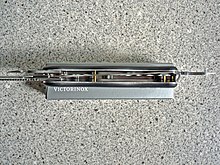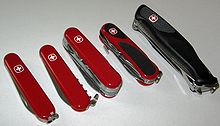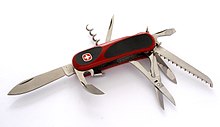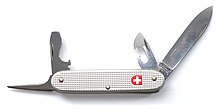They were always another gift idea for a male if you had no idea what to get him.
You don't see them around so much any more, not because the Swiss have become "unpopular" or something, but just by one of those twists and turns of fashions...and requirements of TSA people I believe...
All I know about the Swiss Army Knife is urban folklore, let's see if I can find something more authoritative on the net..
Well, if this doesn't satisfy your curiosity, nothing will:
The Swiss Army knife (French: couteau suisse, German: Schweizer Offiziersmesser: "Swiss officer's knife", Italian: Coltellino svizzero) is a brand of pocket knife or multi-tool manufactured by Victorinox AG and Wenger SA. The term "Swiss Army knife" was coined by US soldiers after World War II due to the difficulty they had in pronouncing the German name.[1]
The Swiss Army knife generally has a blade, as well as various tools, such as screwdrivers and can openers and many others. These attachments are stowed inside the handle of the knife through a pivot point mechanism. The handle is usually red, and features a Victorinox or Wenger "cross" logo or, for military issue knives, the coat of arms of Switzerland.
Originating in Ibach, Switzerland, the Swiss Army knife was first produced in 1891 after the company Karl Elsener, which later became Victorinox, won the contract to produce the Swiss Army's Modell 1890 knife from the previous German manufacturer. In 1893 the Swiss cutlery company Paul Boéchat & Cie, which later became Wenger, received its first contract from the Swiss military to produce model 1890 knives; the two companies split the contract for provision of the knives from 1908 until Victorinox acquired Wenger in 2005.
The design of the knife and its flexibility have both led to worldwide recognition.[2]
History
Origins
During the late 1880s, the Swiss Army decided to purchase a new folding pocket knife for their soldiers. This knife was to be suitable for use by the army in opening canned food and disassembling the Swiss service rifle, the Schmidt-Rubin M1889, which required a screwdriver for assembly.In January 1891, the knife received the official designation Modell 1890. The knife had a blade, reamer, can-opener, screwdriver and grips made out of dark oak wood that was later partly replaced with ebony wood. At that time no Swiss company had the necessary production capacity, so the initial order for 15,000 knives was placed with the German knife manufacturer Wester & Co. from Solingen, Germany. These knives were delivered in October 1891.
In 1891, Karl Elsener, then owner of a company that made surgical equipment, set out to manufacture the knives in Switzerland itself. At the end of 1891 Elsener took over production of the Modell 1890 knives, but Elsener was not satisfied with its first incarnation. In 1896, Elsener succeeded in attaching tools on both sides of the handle using a special spring mechanism: this allowed him to use the same spring to hold them in place, an innovation at the time.[3] This allowed Elsener to put twice as many features on the knife. On 12 June 1897 this knife featuring a second smaller cutting blade, corkscrew, and wood fiber grips was originally registered with the patent office as The Officer's and Sports Knife, though it was never part of a military contract.[4]
Karl Elsener used the cross and shield to identify his knives, the symbol still used today on Victorinox-branded versions. When his mother died in 1909, Elsener decided to name his company "Victoria" in her memory. In 1921 the company started using stainless steel to make the Swiss Army Knife. Stainless steel is also known as "inox", short for the French term acier inoxydable.[5] "Victoria" and "inox" were then combined to create the company name "Victorinox".[6] Victorinox's headquarters and show room are located in the Swiss town of Ibach.
Victorinox and Wenger
Elsener, through his company Victorinox, managed to corner the market until 1893, when the second industrial cutler of Switzerland, Paul Boéchat & Cie, headquartered in Delémont in the French-speaking region of Jura, started selling a similar product. This company was later acquired by its then General Manager, Theodore Wenger, and renamed the Wenger Company. In 1908 the Swiss government, wanting to prevent an issue over regional favouritism, but perhaps wanting a bit of competition in hopes of lowering prices, split the contract with Victorinox and Wenger, each getting half of the orders placed. By mutual agreement, Wenger advertises as the Genuine Swiss Army Knife and Victorinox uses the slogan the Original Swiss Army Knife.Aftermath of World War II
According to Carl Elsener, head of Victorinox in 2009, U.S. soldiers bought Swiss Army knives in huge numbers at PX stores on military bases following the conclusion of the Second World War. As German: Schweizer Offiziersmesser was too difficult for them to say, they called it the "Swiss Army knife", the name by which the knife is now most commonly known worldwide.[2]Recent history
On April 26, 2005 Victorinox acquired Wenger, becoming once again the sole supplier of knives to the Swiss Armed Forces. Victorinox had kept both consumer brands intact, but on January 30, 2013, Wenger and Victorinox announced that the separate knife brands were going to be merged into one brand: Victorinox. Wenger's watch and licensing business will continue as a separate brand.[7]Swiss soldier knife tender
In 2007, the Swiss Government made a request for new updated soldier knives for the Swiss military for distribution in late 2008. The evaluation phase of the new soldier knife began in February 2008, when Armasuisse issued an invitation to tender. A total of seven suppliers from Switzerland and other countries were invited to participate in the evaluation process. Functional models submitted by suppliers underwent practical testing by military personnel in July 2008, while laboratory tests were used to assess compliance with technical requirements. A cost-benefit analysis was conducted and the model with the best price/performance ratio was awarded the contract. The order for 75,000 soldier knives plus cases was worth SFr 1.38 million. This equates to a purchase price of SFr 18.40, €12.12, GB£17.99 in October 2009 per knife plus case. Victorinox won the contest with a knife based on the One-Hand Germany Army Knife as issued by the German Bundeswehr and released in the civilian model lineup with the addition of a tooth-pick and tweezers stored in the nylon grip scales as the One-Hand Trekker/Trailmaster model. Mass production of the new Soldatenmesser 08 (Soldier Knife 08) for the Swiss Armed Forces was started in December 2008.[8]Features
Tools
Various models of Swiss Army knives exist, with different tool combinations for specific tasks designed for everyday carry. The simplest model sold includes only a single blade. The most common tools featured are, in addition to the main blade, a smaller second blade, tweezers, toothpick, corkscrew, can opener, bottle opener, slotted/flat-head screwdriver(s), phillips-head screwdriver, nail file, scissors, saw (regular, wood), file, hook (parcel carrier, tightening aid for shoelaces, etc.), magnifying glass, ballpoint pen, fish scaler, hex wrench w/bits, pliers, and keyring.Recent technological features include USB flash drives, digital clock, digital altimeter, LED light, laser pointer, and MP3 player.[citation needed] The Victorinox Cybertools have many tools of use with computers and electronic equipment. In addition to the usual tools, including pliers and scissors, they have a 4 mm hex screwdriver bit holder and bit case with 4 double-ended bits (8 ends).[9] In January 2010 Victorinox presented the Presentation Master model line to be released in April 2010. The technologically most advanced model includes a laser pointer, a 32 GB detachable flash drive and Bluetooth. One of the Presentation Master models will be the bladeless Presentation Master Flight model. Besides being lightweight, protected and portable, this bladeless Presentation Master version is permitted to be carried on airplanes. For added convenience, the flash drive component is removable, offering travelers the option to carry their data while storing their pocket tool in their checked baggage.[10]
Since 2006 Wenger has produced a knife called "The Giant" that includes every implement the company has ever made.[11] With 87 tools and 141 different functions it is recognised by the Guinness Book of Records as the world's most multifunctional penknife.[12] It retails for about EUR 798 or USD 1,000, though some vendors demand much higher prices.[13] In the same year Victorinox released SwissChamp XAVT which includes 80 functions, with retail price of USD 425.[14] The Guinness Book of Records recognizes a unique 314-blade Swiss Army-style knife made in 1991 by Master Cutler Hans Meister as the world's largest penknife, weighing 11 pounds.[2]
Locking mechanisms

Dual liner lock system as used in the Soldatenmesser 08 and various other Victorinox 111 mm models
Applied materials
Rivets and flanged bushings made from brass hold all machined steel parts and other tools, separators and the scales together. The rivets are made by cutting and pointing appropriately sized bars of solid brass.The separators between the tools have been made from aluminium alloy since 1951. This makes the knives lighter. Previously these separating layers were made of nickel-silver.[16]
The martensitic stainless steel alloy used for the cutting blades is optimized for high toughness and corrosion resistance and has a composition of 15% chromium, 0.60% silicon, 0.52% carbon, 0.50% molybdenum, and 0.45% manganese and is designated X55CrMo14 or 1.4110 according to Victorinox. After a hardening process at 1040 °C and annealing at 160 °C the blades achieve an average blade steel hardness of 56 HRC. This steel hardness is suitable for practical use and easy resharpening, but less than achieved in stainless steel alloys used for blades optimized for high wear resistance.[17][18][19]
According to Victorinox the martensitic stainless steel alloy used for the parts is X39Cr13 or 1.4031 and for the springs X20Cr13 or 1.4021.[20]
The steel used for the wood saws, scissors and nail files has a steel hardness of HRC 53, the screwdrivers, tin openers and awls have a hardness of HRC 52, and the corkscrew and springs have a hardness of HRC 49.
The metal saws and files, in addition to the special case hardening, are also subjected to a hard chromium plating process so that iron and steel can also be filed and cut.[16][21]
Although red cellidor scaled Swiss Army Knives are most common, there are many colors and alternative materials like nylon and aluminium for the scales available.[22] Many textures, colors and shapes now appear in the Swiss Army Knife. Since 2006 the scales on some knife models can have texturized rubber non-slip inlays incorporated, intended for sufficient grip with moist or wet hands. A modding community has also developed, resulting in custom models produced with colorful anodized patterns or wood handles.[citation needed]
Assembly
During assembly, all components are placed on several brass rivets. The first components are generally an aluminium separator and a flat steel spring. Once a layer of tools is installed, another separator and spring are placed for the next layer of tools. This process is repeated until all the desired tool layers and the finishing separator are installed. Once the knife is built, the metal parts are fastened by adding brass flanged bushings to the rivets. The excess length of the rivets is then cut of to make them flush with the bushings. Finally the remaining length of the rivets is flattened into the flanged bushings.After the assembly of the metal parts, the blades are sharpened to a 15° angle, resulting in a 30° V-shaped steel cutting edge. The blades are then checked with a laser reflecting goniometer to verify the angle of the cutting edges. Finally the scales are pressed onto the flanged bushings. The scales are being held in place by holes incorporated in the insides of the scales that result in a tight shape connection with the flanged bushings.[23]
Size
Victorinox Swiss Army knives use 58 mm (2.3 in), 74 mm (2.9 in), 84 mm (3.3 in), 91 mm (3.6 in), 93 mm (3.7 in), 100 mm (3.9 in), 108 mm (4.3 in) and 111 mm (4.4 in) closed length steppings. The thickness of the knives varies depending on the number of tool layers included. The 91 mm (3.6 in) knives offer the most variety in tool configurations in the Victorinox model line.[24]Wenger Swiss Army knives use 65 mm (2.6 in), 75 mm (3.0 in), 85 mm (3.3 in) 93 mm (3.7 in), 100 mm (3.9 in) and 120 mm (4.7 in) closed length steppings. Thickness varies depending on the number of tool layers included. The 85 mm (3.3 in) knives offer the most variety in tool configurations in the Wenger model line.[25]
Manufacturers
Main articles: Victorinox and Wenger
Many other companies manufacture similar-looking multi-tool folding knives in a wide range of quality and prices. The color red for multi-function knives, the cross-and-shield emblem, and the words SWISS ARMY are registered trademarks of Victorinox AG and its related companies.[citation needed]
Knives issued by the Swiss military

Modell 1908, the knife that was issued from 1908 to 1951.[26]
- Modell 1890
- Modell 1890 Ausführung 1901
- Modell 1908
- Modell 1951
- Modell 1951 Ausführung 1954
- Modell 1951 Ausführung 1957
- Modell 1961
- Modell 1961 Ausführung 1965
- Modell 1961 Ausführung 1978
- Modell 1961 Ausführung 1994
- Soldatenmesser 08 (Soldier Knife 08)
Soldier Knife model 1961
The Soldier Knife model 1961 was in use by the Swiss Armed Forces from 1961 to 2008 has a 93 mm (3.7 in) long knurled alox handle with the Swiss crest, a blade, a reamer, a blade combining bottle opener, screwdriver, and wire stripper, and a combined can-opener and small screwdriver and it weighs 72 g (2.5 oz).This official Swiss military model also contains a brass spacer, which allows the knife, with the screwdriver and the reamer extended simultaneously, to be used to assemble the SIG 550 and SIG 510 assault rifles: the knife serves as a restraint to the firing pin during assembly of the lock.
This and later models of the Swiss Soldier Knife were manufactured only by Victorinox and Wenger.
Soldier Knife 08
The Soldier Knife 08 was first issued to the Swiss Armed Forces beginning with the first basic training sessions of 2009.[28]The Soldier Knife 08 features an 111 mm (4.4 in) long ergonomic handle with polymer texturized non-slip inlays incorporated in the nylon grip shells and a double liner locking system, one-hand 86 mm (3.4 in) long locking partly serrated chisel ground drop point blade, wood saw, can opener with small 3 mm (0.12 in) screwdriver, locking bottle opener with large 7 mm (0.28 in) screwdriver and wire stripper/bender, reamer, Phillips (PH2) screwdriver and keyring. The Soldier Knife 08 width is 34.5 mm (1.36 in), height is 18 mm (0.71 in), overall length opened is 197 mm (7.8 in) and it weighs 131 g (4.6 oz).
Knives issued by other militaries
The armed forces of more than 20 different nations have issued their own versions of the Swiss army knife, among them the forces of Germany, France, the Netherlands and Malaysia.[29]Cultural impact
The Swiss Army knife has been added to the collection of the New York Museum of Modern Art (MoMA) and Munich's State Museum of Applied Art for its design and the term "Swiss Army" currently is a registered trademark owned by Victorinox AG and its subsidiary Wenger SA.[30]The television show MacGyver features Angus MacGyver who frequently uses a Swiss Army knife to solve problems and construct simple objects.
The term "Swiss Army knife" has entered popular culture as a metaphor for usefulness and adaptability.[31] The multi-purpose nature of the tool has also inspired a number of other gadgets.[32]












No comments:
Post a Comment
Please leave a comment-- or suggestions, particularly of topics and places you'd like to see covered